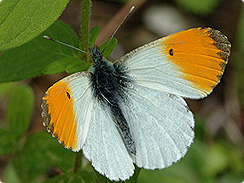
© Jim AsherOrange Tip Butterfly
Butterfly numbers have fallen to a new low, according to data from the UK Butterfly Monitoring Scheme.
British butterflies have been declining steadily for years. The new statistics show that recent wet summers have accelerated these declines. Heavy rain makes it hard for butterflies to survive - they can't fly in the rain and that means they can't reach the nectar they feed on. Rain also reduces breeding success.
The relative absence of breeding during the dire summer of 2007, the wettest on record, impacted seriously on butterfly numbers last year.
The statistics confirm conservationists' fears that 2008 was the poorest summer for butterfly numbers for more than 25 years.
For 12 species 2008 was their worst year since records began in the mid 1970s.
The list includes several once familiar garden visitors whose numbers have dwindled in recent years, for example, the Orange-tip, a beautiful spring butterfly, and the Small Tortoiseshell, which has declined drastically over the last decade.
The figures also show that some butterflies are rapidly becoming extinct in parts of the country.
Species causing concern include one of our rarest butterflies, the High Brown Fritillary. Dr Tom Brereton, Head of Monitoring with Butterfly Conservation, said: "There are now fewer than 50 High Brown Fritillary colonies in the entire country, many of them small. The recent bad weather has pushed an alarming number of these to the brink of extinction".
Other threatened butterflies with worryingly low numbers include the Pearl-bordered Fritillary and the Wood White.
There is also great concern over several formerly common butterflies that have declined dramatically in recent decades, including the Small Heath, Small Copper and Wall.
Butterflies are important as indicators, alerting us to underlying problems with the environment. If butterfly numbers are falling, inevitably other wildlife is also suffering and in decline.
The main factors causing the long term decline of many butterfly species include the loss of crucial habitats such as flower rich grassland and the intensification of farming methods. A lack of management is also causing problems in habitats such as woodlands.
Butterfly Conservation is working with landowners and other conservation organisations to help reverse declines as a matter of great urgency.
Dr Brereton said: "We just hope that this year we don't have another dire summer and that butterfly numbers are able to recover."
The UK Butterfly Monitoring Scheme is operated by Butterfly Conservation and the Centre for Ecology & Hydrology (CEH). Each year it collates data collected by thousands of volunteers. Dr Marc Botham, a butterfly ecologist at CEH who analysed the 2008 results commented "The results show the enormous value of long running datasets in identifying environmental problems. We are enormously grateful to the 1,500 volunteers who contribute each year, making the UKBMS one of the world's most important resources for understanding insect populations"

Reader Comments
to our Newsletter